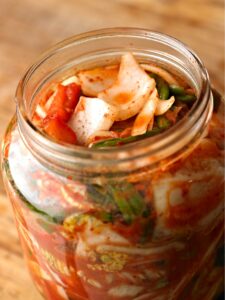Fermentation: An Easy Way to Preserve Vegetables
go.ncsu.edu/readext?1011281
en Español / em Português
El inglés es el idioma de control de esta página. En la medida en que haya algún conflicto entre la traducción al inglés y la traducción, el inglés prevalece.
Al hacer clic en el enlace de traducción se activa un servicio de traducción gratuito para convertir la página al español. Al igual que con cualquier traducción por Internet, la conversión no es sensible al contexto y puede que no traduzca el texto en su significado original. NC State Extension no garantiza la exactitud del texto traducido. Por favor, tenga en cuenta que algunas aplicaciones y/o servicios pueden no funcionar como se espera cuando se traducen.
Português
Inglês é o idioma de controle desta página. Na medida que haja algum conflito entre o texto original em Inglês e a tradução, o Inglês prevalece.
Ao clicar no link de tradução, um serviço gratuito de tradução será ativado para converter a página para o Português. Como em qualquer tradução pela internet, a conversão não é sensivel ao contexto e pode não ocorrer a tradução para o significado orginal. O serviço de Extensão da Carolina do Norte (NC State Extension) não garante a exatidão do texto traduzido. Por favor, observe que algumas funções ou serviços podem não funcionar como esperado após a tradução.
English
English is the controlling language of this page. To the extent there is any conflict between the English text and the translation, English controls.
Clicking on the translation link activates a free translation service to convert the page to Spanish. As with any Internet translation, the conversion is not context-sensitive and may not translate the text to its original meaning. NC State Extension does not guarantee the accuracy of the translated text. Please note that some applications and/or services may not function as expected when translated.
Collapse ▲ Fermentation can be one of the easiest ways to preserve summer time vegetables. You do need a cool environment but if you can control for the really hot days, sauerkraut, fermented pickles and kimchi are great ways to have your vegetables last into the winter months.
Fermentation can be one of the easiest ways to preserve summer time vegetables. You do need a cool environment but if you can control for the really hot days, sauerkraut, fermented pickles and kimchi are great ways to have your vegetables last into the winter months.
Fermentation is practiced at home for many reasons including preservation, flavor enhancement, tradition and suggested health benefits. Common fermented foods are sauerkraut, kimchi, pickles, yogurt and kombucha. Foods are preserved by adding bacteria that converts sugars into acids. The higher acidity of these foods preserves them by preventing the growth of harmful bacteria. On this page you will find resources for safely fermenting foods at home.
Fermentation is the process of using bacteria and/or yeast to convert the foods’ carbohydrates into acid, carbon dioxide and/or alcohol which then work to preserve the food from spoilage. Vegetable fermentation rely on Lactic Acid Bacteria or LAB to help with this preservation. It is the primary bacteria in Sauerkraut, Kimchi and fermented pickles. For more of the health benefit, refrigerate these fermented foods which allows for the beneficial bacteria to provide some of their protective support to our immune system.
Here are some of the most common fermented vegetables you can make at home.
Kimchi
- Naturally fermented vegetables usually Napa cabbage or radishes but other vegetables are possible to use.
- Taste regularly until it reaches the desirable flavor.
- Store in the refrigerator or can be frozen for longer storage.
- Kimchi Recipe
Sauerkraut
- Naturally fermented product using cabbage and canning salt.
- Sour taste created when LAB coverts cabbage’s carbohydrates to lactic acid
- Store by refrigerating, canning (but may lose probiotic benefits) or freezing
- Sauerkraut Recipe
Fermented Pickles
- Naturally fermented cucumbers
- Ferments in a brine prepared from canning salts, vinegar and water
- Store in refrigerator or by canning.
- Fermented Pickles Recipe
It is important when fermenting to be at the correct temperature. Below 60ºF and foods may not ferment and temperatures above 75ºF may result in fermented foods being too soft or spoiling before they ferment.
You also want to make sure you use the proper containers when fermenting. You do not want to use aluminum, copper, brass, galvanized or iron containters since they can react with the acid. It is best to use large stoneware crocks, large glass jars or other food grade containers.
Fermented foods can be stored in the refrigerator at 41ºF or below for up to 3 months. Sauerkraut and fermented cucumber pickles can be canned in a boiling water bath for longer storage. Kimchi and Sauerkraut can also be frozen.
For more information about fermentation and also safety and troubleshooting advice visit NC State Safe Plates.
For information on hands on canning classes this summer check out the the classes we will have at the WNC Foodworks and WNC Farmers Market.




